Cycles Approach for Speech Therapy | Cycles for Phonology
When a child is highly unintelligible (very hard to understand), we can use a Cycles Approach to help them catch up in speech more quickly.
A Cycles Approach improves speech production by targeting each speech error for a short time and then cycling through many targets over the course of several weeks.
This allows a child to make progress on multiple sounds at once.
This page shows how to use the Cycles Approach for Phonology in speech therapy for highly unintelligible children. The Cycles for Phonology Curriculum by SLK provides training and materials for use with this approach.
What is the Hodson Cycles Approach to Speech Therapy?
An amazing speech-language pathologist named Barbara Hodson created the cycles approach, sometimes called the Cycles Phonological Remediation Approach as a way to help children with many phonological processes make faster progress in speech therapy.
Hodson’s research showed that children can improve their intelligibility faster by cycling through all of the different phonological processes that they need to target
Instead of working on one phonological process until it is mastered, you work on each process for a set amount of time and then move on to the next.
How Does the Cycles Approach to Phonology Work?
- Choose your patterns for the first cycle: Hodson has a list of “primary set” targets that you can use for the first rounds. Choose the error patterns from that list that the child is stimulable for. (We don’t work on non-stimulable error patterns yet)
- Choose at least 2 phonemes per pattern: For example, if you’re working on final consonant deletion, then you might work on final /t/ one week and final /k/ the next week.
- Practice each phoneme for a week: Each phoneme (e.g. /k/) within a pattern (e.g. velars) is targeted for 60 minutes in one week (two 30-minutes or three 20)
- Choose 4-5 targets to practice: Choose 4-5 words to practice repeatedly during those 60 minutes. They should be stimulable for these words so that all productions are successful
- Cycle back around: Once cycle is done, reassess convo and see what they still need. Recycle any patterns that aren’t emerging in conversation
When to Use the Cycles Approach:
The cycles approach to speech therapy is intended for children who meet the following criteria:
- Highly unintelligible (very difficult to understand)
- Frequently leave out or omit speech sounds
- Replace some sounds with other sounds
- Don’t use very many different consonant sounds
The Purpose of the Cycles Approach:
The cycles approach is meant to more closely mirror the natural development of phonology in young children where many processes are developed gradually over time by mastering easiest words first.
The researchers of this method claim that it improves intelligibility more quickly for highly unintelligible children than other methods.
Program and Materials for the Cycles Approach:
Here at Speech and Language Kids, we’ve created a full program and materials kit for using the Cycles Approach. You can get access to this through our SLK Curriculum portal:
Which Phonological Processes to Target First:
Barbara Hodson laid out a nice plan for which phonological processes to target first when using the cycles approach. First, you start with processes that are on Hodson’s “primary set” of targets. These are the processes that impact speech intelligibility the most.
The key is to only include targets (phonological processes) that the child is stimulable for. The goal is to have them practice these targets successfully as many times per cycle as possible. The only exception is gliding, which is targeted with all clients even if they are not stimulable. For this process, you will help them approximate the /l/ and /r/ if they are not stimulable for those sounds yet.
If there is a phonological process in the primary set that the child is not yet stimulable for, use a few minutes each session to work on increasing their stimulability of those sounds.
Primary Set of Targets:
- Syllable deletion: make sure each syllable is marked, even if not all sounds are present
- Sound deletion (FCD, ICD)
- /s/ clusters: significantly improves intelligibility
- Fronting/Backing (Anterior/Posterior Contrasts): Work on velars if fronting or alveolars/labials if backing
- Liquids are targeted at the end of each cycle even if they aren’t stimulable (this is the only exception to the stimulability rule): Target /l/ and /r/ (by emphasizing vowel to suppress the /w/ substitution, go for an approximation)
Criteria for Moving on to Secondary Targets:
Secondary patterns are not targeted until the following criteria have been achieved in spontaneous utterances:
- Appropriate syllableness (including all syllables)
- Productions of singleton consonants (not omitting sounds)
- Some emergence of /s/ clusters and velars in conversation
- Productions of practice words for /l/ and /r/ without inserting the glide
Secondary Targets:
The most common secondary targets to choose include:
- Palatals (glide /j/, sibilants “sh”/”zh”, /r/)
- All other consonant clusters/sequences (eg. /j/ clusters, medial /s/ clusters, 3-consonant clusters)
- Other singleton stridents (/f/, /s/, /z/)
- Any remaining vowel/diphthong or prevocalic voicing/devoicing difficulties
.
.
Cycles Approach Steps
Here’s how you’ll run your cycles during the cycles approach:
- Choose your phonological processes for the first cycle (example: “final consonant deletion”)
- Choose at least 2 phonemes per pattern (example: “final /t/ and final /p/”)
- Each phoneme (e.g. /k/) within a process (e.g. velars) is targeted for 60 minutes in one week (two 30-minutes or three 20-minutes)
- Choose 4-5 words to target over and over during those 60 minutes. They should be stimulable for these words so that all productions are successful
- Once cycle is done, reassess convo and see what they still need. Recycle any phonological process that aren’t emerging in conversation
Cycles Approach Steps for Each Therapy Session
- Review: Review the previous session’s word cards.
- Auditory Bombardment: Amplified auditory stimulation is provided for 1-2 minutes: the clinician reads around 12 words that contain the target pattern for the session.
- Target Word Cards: The client draws, colors, or pastes pictures of 3-5 target words on large index cards. Child repeats the words modeled by the clinician.
- Production Practice through Experiential Play: While playing games, clinician and child take turns naming the pictures on the cards. Clinician provides models and tactile cues. The child should achieve 100% accuracy (choose words that are the easiest for the child to produce).
- Stimulability Probe: The clinician asks the child to say a bunch of words that contain the target pattern for the next session. Whichever sound is easiest for the child will be targeted during the next session (for example, the child may have to say a bunch of /s/ clusters and the easiest one is selected for practice).
- Auditory Bombardment: Repeat step 2.
- Home Program: The child practices 2 minutes per day by having a parent or aide read the list aloud and then naming the picture cards of the production practice words.
What Phonemes to Choose for Each Phonological Process/Pattern:
- Syllable Deletion:
- Compound words (cowboy, baseball)
- Three-syllable/word combinations (cowboy hat, baseball bat)
- Sound Deletion
- Initial consonants: labial stops (/p/, /b/, /m/), glide /w/
- Final consonants: Voiceless word-final stops (/p/, /t/, /k/), /m/, /n/ (only if those sounds are in their spontaneous speech somewhere)
- Medial sounds in VCV, like “apple”
- /s/ Clusters
- Add /s/ to consonants the child is already producing
- Word initial: /sp/, /st/, sm/, etc.)
- Word final: /ts/, /ps/
- Incorporate “It’s a ____” when able to produce /s/ clusters in practice words (typically by third cycle)
- Anterior/Posterior Contrast
- Velars (if fronting)
- Word-final /k/ (before prevocalic velars, never final /g/)
- Word-initial /k, g/
- Alveolars/labials (if backing)
- Facilitation of Liquids (even if not stimulable)
- Word-initial /l/ (preceded by week of tongue tip clicking)
- Word-initial /r/ (suppress gliding initially): Exaggerate and prolong the vowel (rather that the /r/), do not blend initially
- Incorporate /kr/, and /gr/ when child has velars (typically by third cycle)
Our Cycles Approach Materials Kit:
I know you don’t have a lot of extra time in your day so I’ve made this all simpler. I’ve created a full materials kit that provides you worksheets and homework for every phoneme in the primary set of phonological approaches. You can plan out which processes you’ll hit in a cycle with our planning sheets (below) and then grab the correct page and you’re ready for therapy!
Sources:
1.Prezas, R. F., & Hodson, B. W. (2010). The cycles phonological remediation approach. In A. L. Williams, S. McLeod, & R. J. McCauley (Eds.), Interventions for speech sound disorders in children (pp. 137–158). Baltimore, MD: Brookes.
(Posted here: https://coe.uoregon.edu/cds/files/2016/04/The-Cycles-Phonological-Remediation-Approach.pdf )
Or, to see what the American Speech-Language Hearing Association (ASHA) has to say, click here to view the ASHA Cycles Approach Information.
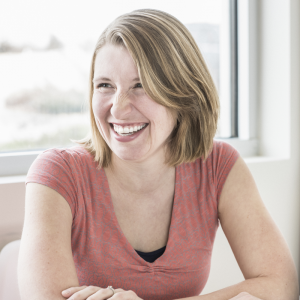
About the Author: Carrie Clark, MA CCC-SLP
Hi, I’m Carrie! I’m a speech-language pathologist from Columbia, Missouri, USA. I’ve worked with children and teenagers of all ages in schools, preschools, and even my own private practice. I love digging through the research on speech and language topics and breaking it down into step-by-step plans for my followers.
Fun Fact: Though I’ve never gone for an official diagnosis, I meet the diagnostic criteria for ADHD so I’ve diagnosed myself (can I do that??). Understanding that my brain works differently from some has been HUGE to helping me become the best version of me possible. The most helpful revelation was understanding that my brain is motivated by novelty, hyper interests, and challenges. I feel strongly that having ADHD, and learning how to channel my hyperfocus, has been instrumental in my success as an entrepreneur.
Connect with Me:
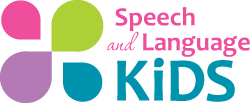
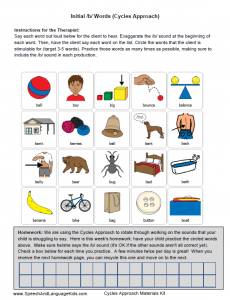
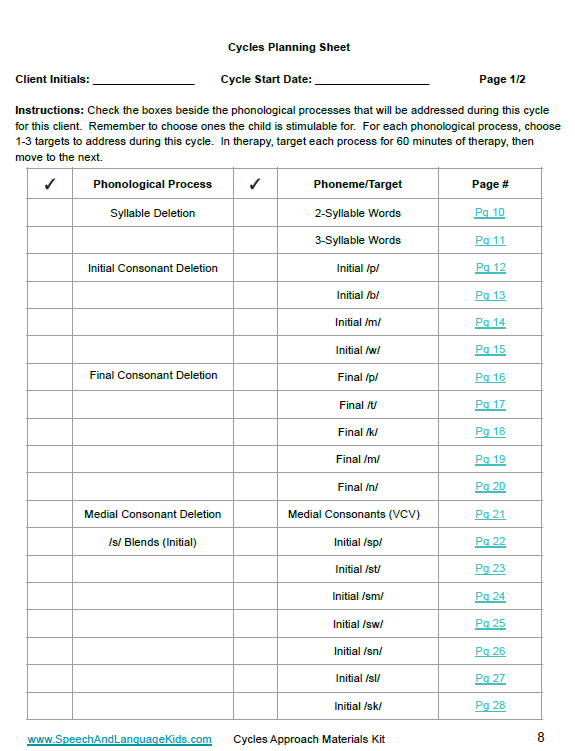
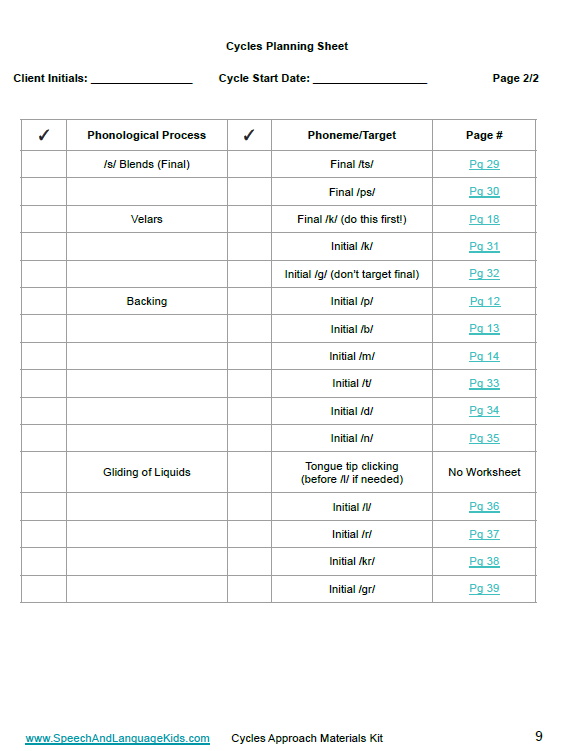

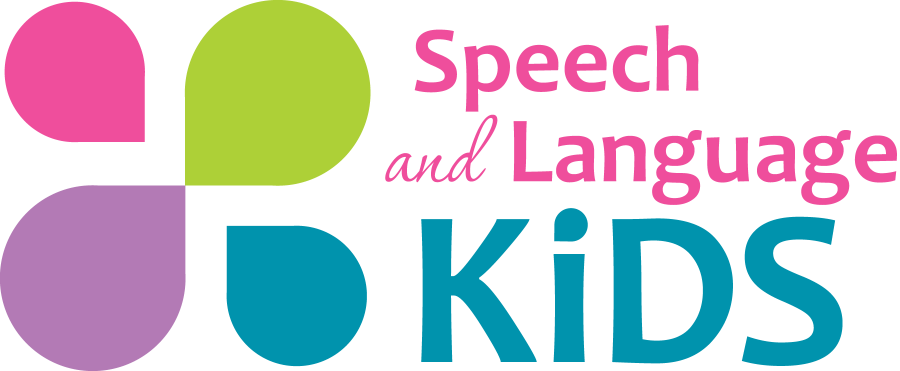
Perfect timing! Had just been researching the cycles approach for a new student on my caseload! Your information is so helpful and usable.
Thanks you!!!
Excellent! Glad I could read your mind 🙂
thanks!
You’re welcome!
I was not aware of it. This is something new I had learnt.
Glad you were able to benefit from this info!
When the child is not using /k/ or /g/ correctly in any position of words, how do you target these? Do you target a mixture of initial, medial, and final words during your 60 minutes for this sound? Or do you target each position individually? I will be doing 3×20 min. sessions. So I was thinking final /k/ for session #1, initial /k/ for session #2, and medial /k/ for session #3 and then targeting /g/ the next week? What if they do not achieve 100% accuracy at the word level during the first 60 min.? Do you continue to target the sound/pattern until they are at 100% accuracy in words? Sorry so many questions. I really want to try using this method and just need some guidance
Hi, Thanks for the info! How do you pick the 3-5 target words. I don’t want to pick things that are too hard for my patient. This little girl in particular is having a really difficult time with stopping, fronting, AND backing so those are the three I would like to choose to work on but she can’t do ANYTHING I ask her to imitate so I’m having a hard time with choosing a starting place. She can produce all of the sounds. With stopping for instance, she says “car” for “far” and if you ask her to make /f/ sound she says “fkar.” I’m just really struggling and feel like I have tried everything and no progress is being made. Any help or advice is welcome.
Thank you so much!I had seen Hodson at our state convention and bought her book, but the flow chart is very helpful.
Hello what if the child doesn’t even speak at all, how to address that?
Hi, Mary-You can check out this link for Carrie’s free sources on non verbal children: https://www.speechandlanguagekids.com/functional-communication/. If you need additional help, please let us know.
This is very helpful! What do you use for amplification? Do you have an amazon link for a small FM system of amplifier?
Thanks!
Hi, Nichole-I found an article on Carrie’s site regarding hearing loss that may be of some help to you. You can view it here: https://www.speechandlanguagekids.com/5-tips-getting-started-therapy-children-hearing-loss/. Please let us know if you need anything else.
I think Nichole C. (above) probably was referring to the word used in the featured article on Cycles Approach, in #2 of How to Run Each Session”. As mentioned in the article under “How to Run Each Session” #2 says “Auditory Bombardment: Amplified auditory stimulation is provided for 1-2 minutes: the clinician reads around 12 words that contain the target pattern for the session.” Is Carrie really saying we need to make the auditory bombardment louder? Or does she mean “amplified” in another way, like speed of presenting the words or using lots of words for that minute or two? I wondered what “amplified” meant there too. Can I get some clarification on that from Carrie. I’ thinking she was not referring to hearing loss as Kena was thinking in her response to Nichole. Thanks!
“Hello, Sharon! Thanks so much for reaching out. We would love to help you with this problem. I see that you’re a paid member of The SLP Solution membership. We have two convenient ways for you to ask our staff your question. You can either ask on the members-only Facebook group or ask in our private forum. Here are the links:
Members-Only Facebook Group: https://www.facebook.com/groups/693004254147275
Private Forum on the Membership Site: https://members.slpsolution.com/forum/
Please let us know if you have any trouble accessing those areas!
I really love the cycles approach! I’ve seen so much great progress using it.
When the child is not using /k/ or /g/ correctly in any position of words, how do you target these? Do you target a mixture of initial, medial, and final words during your 60 minutes for this sound? Or do you target each position individually? I will be doing 3×20 min. sessions. So I was thinking final /k/ for session #1, initial /k/ for session #2, and medial /k/ for session #3 and then targeting /g/ the next week? What if they do not achieve 100% accuracy at the word level during the first 60 min.? Do you continue to target the sound/pattern until they are at 100% accuracy in words? Sorry so many questions. I really want to try using this method and just need some guidance
Hello! Thanks so much for reaching out! Barbara Hodson recommends not targeting a process until the child is stimulable for it. If the child is not yet stimulable for velars, you wouldn’t target it during the initial set. But she recommends you spend a few minutes at the beginning of each session trying to probe for stimulability on those sounds. Try a few strategies, like using a lollipop or laying on their back to let gravity assist. Then, if you can get them stimulable by your next cycle, you would be able to target velars then. As for the position, Hodson recommends breaking them out and working on initial and final in separate weeks/cycles. She also recommends that you only practice words that they are successful with.
Have you watched our cycles approach course yet? It answers a lot of the questions that you’re answering here in way more depth than I can cover in an email. It also includes all of the materials you need for the initial set. Here’s the link if you are interested!
https://go.slpreboot.com/courses/cycles-approach-for-phonological-disorders-course-and-materials-kit
I hope that helps!
I absolutely love the way you broke everything down! Definitely helped me understand the Cycle Approach, thank you!
You are most welcome, Kasandra! Please let us know if you have any questiobns.
do you have strategies for epenthesis? my 9 yo student adds “ch” to everything in English, but not in her first language, Spanish.
I would start by having her differentiate when you add a “ch” and when you don’t. So for example, you would say a word they way she says it and then also the correct way and see if she can hear the difference. Once she can hear it in your speech, it will be able to work on having her stop it in her own speech.